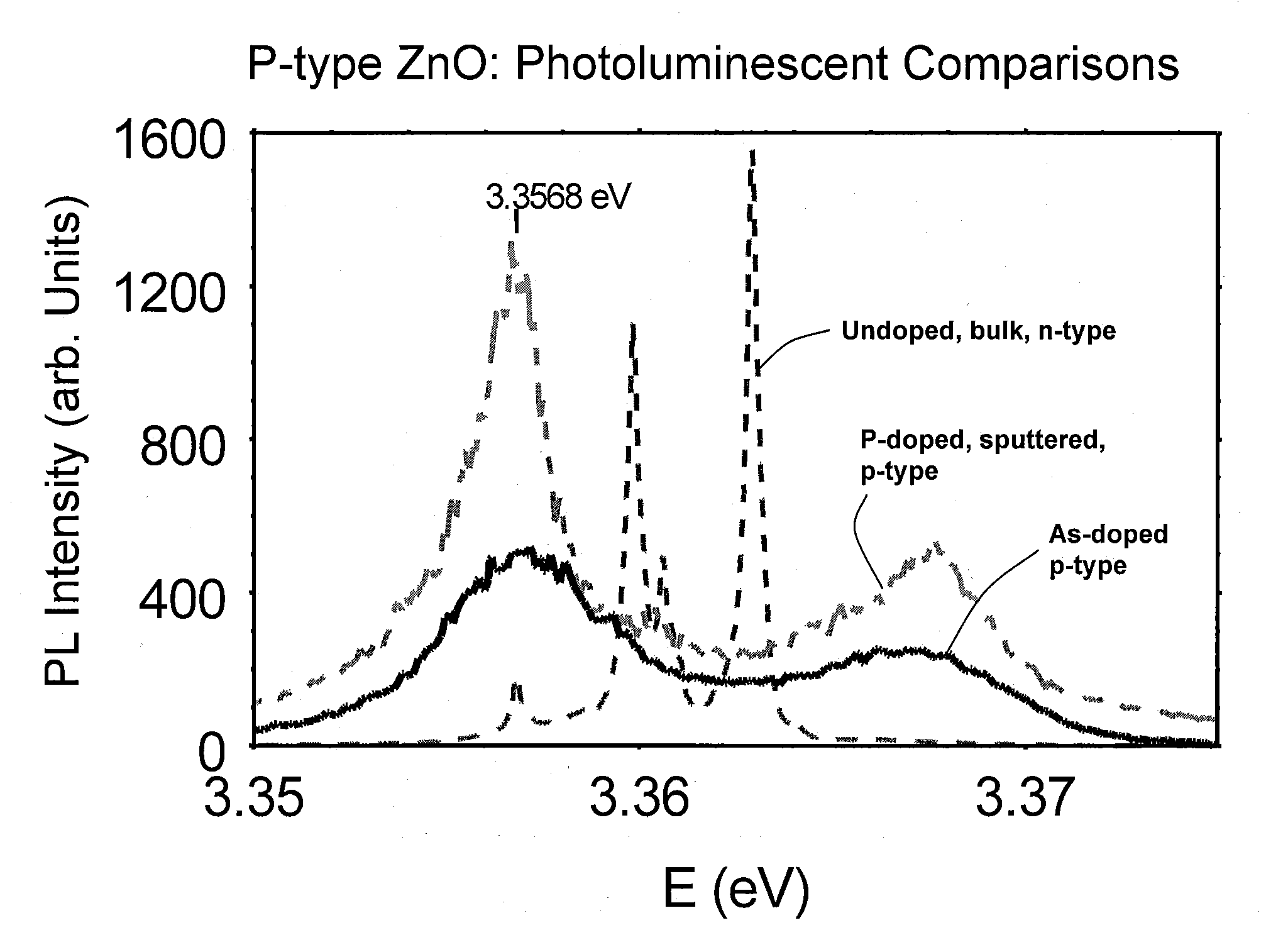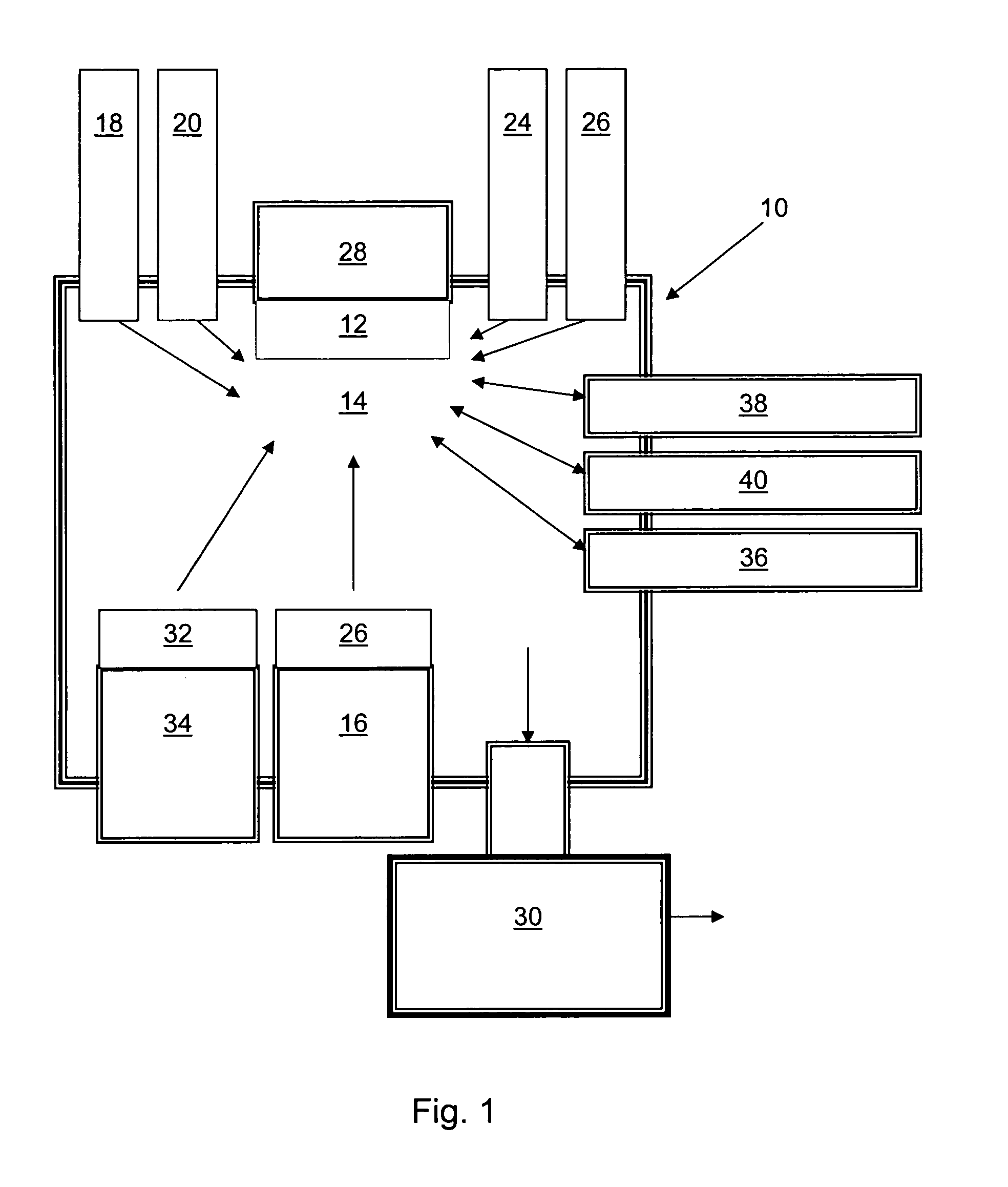Group II-VI semiconductor devices
- Summary
- Abstract
- Description
- Claims
- Application Information
AI Technical Summary
Benefits of technology
Problems solved by technology
Method used
Image
Examples
example 1
Sputtering of ZnO with Arsenic as a Dopant
[0067]A thin film of p-type zinc oxide was deposited onto a self supporting substrate by RF sputtering. Both fused silica and silicon wafers were used as the self supporting substrate. The sputtering target composition was ZnO (0.99-0.95 moles)+As (0.01-0.05 moles). The preferred target composition was ZnO (0.98 moles)+As (0.02 moles). The substrate temperature was between 350 and 550° C. The preferred temperature was about 400° C. The RF power was between 20 and 120 watts. The preferred power was about 60 watts. The sputtering atmosphere included argon at a gas pressure of about 4 to 20 mtorr and O2 at a gas pressure of about 1 to 4 mtorr. The preferred sputtering atmosphere pressures were about 9 mtorr argon and about 1 mtorr O2.
[0068]The resulting transparent p-type zinc oxide layer had a resistance of about 10,000 ohms / square. After annealing at 440° C. in air, the resistance dropped to about 1,000 ohms / square. In another composition pre...
example 2
Sputtering of ZnO with Arsenic as a Dopant
[0069]A thin film of p-type zinc oxide was deposited onto a self supporting substrate by RF sputtering. Both fused silica and silicon wafers were used as the self supporting substrate. The sputtering target composition was ZnO (0.99-0.95 moles)+As (0.01-0.05 moles). The preferred target composition was ZnO (0.98 moles)+As (0.02 moles). The substrate temperature was between 350 and 550° C. The preferred temperature was about 400° C. The RF power was between 20 and 120 watts. The preferred power was about 60 watts. The sputtering atmosphere included argon at a gas pressure of about 4 to 20 mtorr and H2 at a gas pressure of about 1 to 4 mtorr. The preferred sputtering atmosphere pressures were about 9 mtorr argon and about 1 mtorr H2.
[0070]The resulting transparent p-type zinc oxide layer had a resistance of about 500 ohms / square. Without being bound by theory, it is believed that the hydrogen gas may be moderating the concentration of oxygen i...
example 3
Sputtering of ZnO with Arsenic as a Dopant
[0071]A thin film of p-type zinc oxide was deposited onto a self supporting substrate by RF sputtering. Both fused silica and silicon wafers were used as the self supporting substrate. The sputtering target composition was ZnO (0.99-0.95 moles)+As (0.01-0.05 moles). The preferred target composition was ZnO (0.975 moles)+As (0.025 moles). The substrate temperature was between 350 and 550° C. The preferred temperature was about 400° C. The RF power was between 20 and 120 watts. The preferred power was about 60 to 90 watts. The sputtering atmosphere included argon at a gas pressure of about 4 to 20 mtorr. The preferred sputtering atmosphere pressure was about 9 mtorr argon.
[0072]The resulting transparent p-type zinc oxide layer had a resistance of about 1000 ohms / square. The resulting p-type zinc oxide was analyzed by X-ray Photoelectron Spectroscopy (XPS). A graph of the XPS data is shown in FIG. 2. The data from FIG. 2 show arsenic in zinc ox...
PUM
 Login to View More
Login to View More Abstract
Description
Claims
Application Information
 Login to View More
Login to View More - R&D
- Intellectual Property
- Life Sciences
- Materials
- Tech Scout
- Unparalleled Data Quality
- Higher Quality Content
- 60% Fewer Hallucinations
Browse by: Latest US Patents, China's latest patents, Technical Efficacy Thesaurus, Application Domain, Technology Topic, Popular Technical Reports.
© 2025 PatSnap. All rights reserved.Legal|Privacy policy|Modern Slavery Act Transparency Statement|Sitemap|About US| Contact US: help@patsnap.com



